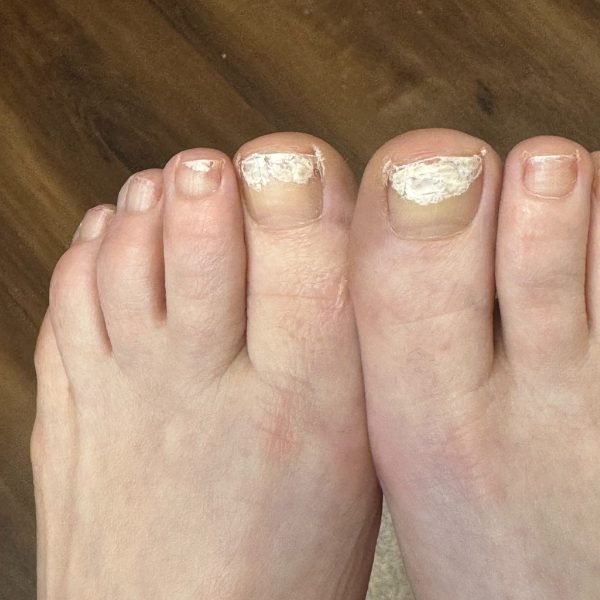

Have you ever noticed a chalky white discoloration or rough texture on your toenails after removing nail polish? These could be keratin granules, a common side effect of prolonged nail polish uses. While they might seem alarming, they are typically harmless and can be easily treated. Let’s dive into what keratin granules are, how to address them, and what other conditions might look similar.
What Are Keratin Granules?
Keratin granules are areas of damage to the top layers of the nail. They show up as small, chalky white spots or rough patches and happen when nail polish, especially if left on too long, dries out and weakens the surface of the nail.
Why Do They Happen?
Keratin granules form when nail polish traps moisture and changes the natural balance of hydration in the nails. Removing nail polish with acetone-based removers can make the problem worse because they dry out the nail plate even more.
How to Treat Keratin Granules
The first step to treating keratin granules is to give your nails a break from nail polish. Let them “breathe” for a few weeks so they can recover. You can also hydrate your nails by applying a strengthening oil or cream with ingredients like vitamin E, jojoba oil, or keratin proteins. Using a gentle urea-based cream can help soften and hydrate the nails at the same time.
If the surface of your nail feels rough, you can lightly buff it with a nail buffer, but be careful not to overdo it since too much buffing can weaken your nails. When you’re ready to start using nail polish again, try applying a protective base coat first. It’s also a good idea to choose nail polishes that are free from harsh chemicals and nail polish removers that don’t contain acetone.
Could It Be Something Else?
Keratin granules can look like other conditions, so it’s important to know what else might be going on. Nail fungus, also called onychomycosis, can cause white, yellow, or brown discoloration, as well as thick, crumbly nails. Psoriasis can also affect nails, causing pitting or white spots, and it’s often linked to other symptoms like red, scaly patches on the skin.
Superficial white onychomycosis, a type of fungal infection, can look similar to keratin granules because it also causes chalky white spots on the surface of the nail. Other conditions, like trauma to the nail, nutritional deficiencies, or overexposure to chemicals, can also cause changes in the nail’s appearance.
Preventing Keratin Granules
To avoid keratin granules, don’t leave nail polish on for longer than 7 to 10 days. When it’s time to remove the polish, use an acetone-free remover that’s gentler on your nails. Afterward, apply a nail and cuticle oil regularly to keep your nails hydrated. Giving your nails a polish-free break every so often can also help keep them healthy. If you do chores that involve harsh chemicals or soaking your hands and feet in water, wear gloves to protect your nails.
When to See a Dermatologist
If the white spots or roughness don’t go away after trying these tips, or if your nails start to thicken, hurt, or separate from the nail bed, it’s time to see a dermatologist. These could be signs of a different condition that needs medical treatment.
Keratin granules might be frustrating, but they’re easy to treat if you know what to do. By taking a little extra care of your nails, you can restore their natural shine and keep them healthy. Your nails work hard—make sure to give them the love they deserve
Disclaimer: The photos shown are actual images of our patient, shared with explicit written consent. These images are for educational use only and may not be copied, distributed, or reproduced without permission from our office.